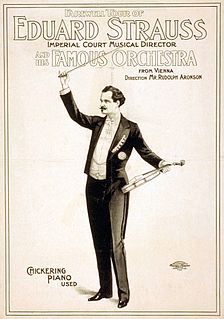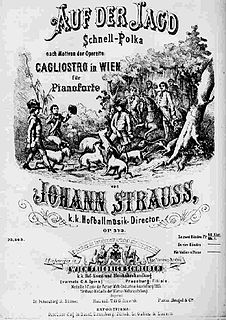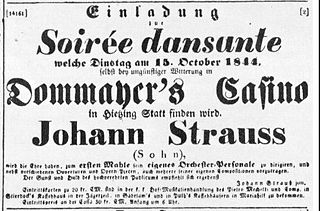
Richard Georg Strauss was a German composer, conductor, pianist, and violinist. Considered a leading composer of the late Romantic and early modern eras, he has been described as a successor of Richard Wagner and Franz Liszt. He along with Gustav Mahler, represents the late flowering of German Romanticism after Wagner, in which pioneering subtleties of orchestration are combined with an advanced harmonic style.

Franz Josef Strauss was a German politician. He was the long-time chairman of the Christian Social Union in Bavaria (CSU) from 1961 until 1988, member of the federal cabinet in different positions between 1953 and 1969 and minister-president of the state of Bavaria from 1978 until 1988. Strauss is also credited as a co-founder of European aerospace conglomerate Airbus.

Levi Strauss & Co. is an American clothing company known worldwide for its Levi's brand of denim jeans. It was founded in May 1853 when German immigrant Levi Strauss moved from Buttenheim, Bavaria, to San Francisco, California to open a west coast branch of his brothers' New York dry goods business. The company's corporate headquarters is located in the Levi's Plaza in San Francisco.

Eduard "Edi" Strauss was an Austrian composer who, together with brothers Johann Strauss II and Josef Strauss made up the Strauss musical dynasty. He was the son of Johann Strauss I and Maria Anna Streim. The family dominated the Viennese light music world for decades, creating many waltzes and polkas for many Austrian nobility as well as dance-music enthusiasts around Europe. He was affectionately known in his family as 'Edi'.
Accelerationen (Accelerations), op. 234, is a waltz composed by Johann Strauss II in 1860 for the Engineering Students' Ball at the Sofienbad-Saal in Vienna. It is one of his best-known waltzes, famous especially for its rapidly accelerating opening waltz theme.
Grillenbanner, opus 247, is a waltz composed by Johann Strauss II. Strauss himself conducted its premiere at a ball in the Sofienbad-Saal in February 1861. The work was dedicated to Prince Leopold of Saxe-Coburg-Gotha.
Donauweibchen, Op. 427, is a waltz composed by Johann Strauss II in December 1887. The composition features melodies from Strauss' operetta Simplicius. It was first performed in January 1888 at one of Eduard Strauss's Sunday concerts in the Musikverein.

"Auf der Jagd", op. 373, is a polka composed by Johann Strauss II. The composition is based on melodies in Strauss' operetta Cagliostro in Wien.

Gunstwerber, Op. 4, is a waltz by Johann Strauss II.

Herzenslust, Op. 3, is a polka composed by Johann Strauss II in the fall of 1844 for his debut as a composer at the Dommayer's Casino establishment in Vienna. It was performed along with several of Strauss' other early compositions, such as the waltzes Sinngedichte and Gunstwerber, and the Debut-Quadrille. Reviewing Strauss' debut, the journal Der Wanderer noted that both the Debut-Quadrille and the Herzenslust Polka "are so piquant in their inspiration, and handled with such glittering effect in the instrumentation that we […] have to recognise and commend the bold and exuberant talent of Strauss Son."
Indigo-Marsch, opus 349, is a march composed by Johann Strauss II. Its melodies are incorporated from Strauss' first operetta, Indigo und die vierzig Räuber. The work was first performed on 9 April 1871 at a concert in the Musikverein in Vienna, with Eduard Strauss conducting.
Carnevalsbilder, opus 357, is a waltz composed by Johann Strauss II. The waltz is based on melodies from Strauss' operetta Der Karneval in Rom. Strauss conducted its first performance in Vienna on July 9 1873. Oscar Straus later arranged the second waltz theme of Carnevalsbilder for his operetta Drei Walzer as the soprano aria Ich liebe das Leben.
Aus den Bergen, opus 292, is the name of a waltz composed by Johann Strauss II. The work was first performed in Pavlovsk on October 2nd 1864, under the title In den Bergen. The composition was dedicated to the music critic Eduard Hanslick. Critics commented on Strauss' waltz that "after a long time a new waltz from Johann Strauss has appeared, which is distinguished by noble and graceful character, and further distinguished by extraordinarily masterful instrumentation." The first Viennese performance of the waltz was in the Volksgarten as part of a benefit concert commemorating Strauss' twentieth anniversary of his debut as a composer.
Waldine, Op. 385, is a polka-mazurka composed by Johann Strauss II. The title is taken from one of Strauss' operettas, Blindekuh. Waldine was the last, as well as the least successful, of the five orchestral dance compositions that Strauss had arranged on tunes from the operetta, having been first performed an entire year after the premiere of the operetta, where it was conducted by Eduard Strauss in the Musikverein in Vienna on December 7, 1879.
Rhadamantus-Klänge, Op. 94, is a waltz composed by Johann Strauss II. It was written for the 1851 Vienna Carnival. The title of the work was named after Rhadamanthus, one of the judges of the underworld in Greek mythology. Eduard Strauss, the composer's youngest brother, included the waltz's opening number in his potpourri Bluthenkranz Johann Strauss'scher Walzer, opus 292.
Lava-Ströme, opus 74, is the name of a waltz composed by Johann Strauss II. It was written to commemorate the volcanic activity within Vesuvius in 1850. The waltz was first performed at a benefit ball going under the title of a "Ball in Vesuvius" at the Sofienbad-Saal in Vienna on January 29, 1850.
The Strauss Family is a 1972 English Associated Television series of eight episodes, about the family of composers of that name, including Johann Strauss I and his sons Johann Strauss II, Eduard Strauss and Josef Strauss.

Eduard Leopold Maria Strauss, commonly known as Eduard Strauss II to distinguish him from his grandfather, was an Austrian conductor whose grandfather was Eduard Strauss I and whose uncle was Johann Strauss III.








